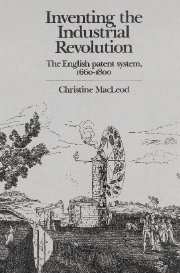Book contents
- Frontmatter
- Contents
- List of tables and figure
- Acknowledgements
- List of abbreviations
- Notes on style
- Introduction
- 1 Patents 1550–1660: law, policy and controversy
- 2 The later-Stuart patent grant – an instrument of policy?
- 3 The development of the patent system, 1660–1800
- 4 The judiciary and the enforcement of patent rights
- 5 The decision to patent
- 6 Invention outside the patent system
- 7 Patents in a capitalist economy
- 8 The long-term rise in patents
- 9 The goals of invention
- 10 Patents: criticisms and alternatives
- 11 A new concept of invention
- Notes
- Bibliography
- Index
4 - The judiciary and the enforcement of patent rights
Published online by Cambridge University Press: 28 October 2009
- Frontmatter
- Contents
- List of tables and figure
- Acknowledgements
- List of abbreviations
- Notes on style
- Introduction
- 1 Patents 1550–1660: law, policy and controversy
- 2 The later-Stuart patent grant – an instrument of policy?
- 3 The development of the patent system, 1660–1800
- 4 The judiciary and the enforcement of patent rights
- 5 The decision to patent
- 6 Invention outside the patent system
- 7 Patents in a capitalist economy
- 8 The long-term rise in patents
- 9 The goals of invention
- 10 Patents: criticisms and alternatives
- 11 A new concept of invention
- Notes
- Bibliography
- Index
Summary
Complex as the procedure was, the purchase of a patent was but the preliminary step in protecting an invention against competition. The security it afforded against alleged interlopers was contingent upon the respect accorded to the authority it professed or the force of the threat it was seen to pose. It is necessary therefore to consider what sort of protection was offered by the law courts. Ideally, a patentee would find the threat of prosecution sufficient to suppress infringements; where his title was genuinely in dispute, arbitration would be simple, quick and cheap. A form of arbitration was available, in the Privy Council, until the mid-eighteenth century, but to secure damages was a different matter, exposing patentees to the delays, expense and uncertainty of equity jurisdiction. It is not hard to imagine that this would have a deleterious effect on the patentee's capacity to deter interlopers. These interrelated questions, of the legal process and the patentee's extra-legal authority, are the subject of this chapter. Its focus is the period 1660–1750. The major patent cases of the late eighteenth century are relatively well known, and Harry Dutton recently examined the century after 1750 from a perspective similar to mine. Dutton found not merely judicial confusion and inconsistency in patent cases, but also considerable prejudice against patentees; this persisted from the late eighteenth century to the mid 1830s, when commentators noted the ‘decided turn which the feelings of judges, jurors and the public have taken in favour of inventors’. Prior to the mid-eighteenth century, there is no evidence that judges held any antipatent prejudices, but confusion and inconsistency were already rife.
- Type
- Chapter
- Information
- Inventing the Industrial RevolutionThe English Patent System, 1660–1800, pp. 58 - 74Publisher: Cambridge University PressPrint publication year: 1988
- 2
- Cited by



